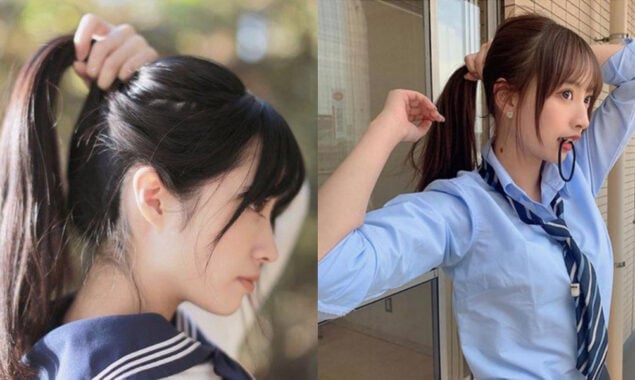
Japanese schools are notorious for their tight regulations on what students can wear, from the length of their socks to the colour of their undergarments. However, one rule has sparked controversy, not just because of its ridiculousness, but also because of the reasoning behind it.
School authorities informed Motoki Sugiyama, a former middle school teacher, that females should not wear ponytails because revealing the nape of their necks may “sexually stimulate” male students.
“They’re concerned that guys would gaze at girls,” Sugiyama told a News channel, pointing to how most schools compel girls to wear white undergarments so that they don’t show through their uniforms.
“I’ve always questioned these regulations, but kids have no option but to accept them since there is such a lack of criticism and it’s gotten so accepted,” he added.
There are no national figures on how many schools still restrict ponytails, but according to a 2020 study, around one out of every ten schools in Fukuoka’s southern prefecture outlawed the hairdo.
Sugiyama has taught at five different schools in Shizuoka prefecture, some 90 miles southwest of Tokyo, over the course of 11 years, all of which prohibited ponytails. And he’s made it his personal goal to reveal unfair demands on students, leading a rising clamour for schools to abandon outdated, overtly sexist, or self-expression-inhibiting policies.
The Japanese government requested that all prefectural boards of education amend harsh school rules following outrage from students and parents in June. While some institutions have changed their methods, many decades-old habits are taking a long time to vanish.
A ponytail prohibition is only one of several severe laws enforced on students in Japan, known as buraku kosoku. The colour of pupils’ undergarments and socks, as well as the length of their skirts and the form of their eyebrows, are all governed by the laundry list of rules. Another problematic issue is hair colour; some institutions require photographic evidence of a student’s true hair colour if it isn’t perfectly “black and straight.”
Students are seldom given an explanation for such laws, according to Sugiyama, who films movies criticising Japan’s education system and buraku kosoku on TikTok.

The grounds for enforcing such laws were frequently capricious. Schools that prohibit ponytails, for example, frequently accept bob haircuts, even though they show the same amount of the neck as ponytails.
It was reportedly to avoid a domino effect of outrageous haircuts at subsequent periods. Similarly, the undercut, a haircut in which the sides are shaved but the top is left long, is disallowed.
“Because if the two-block (undercut) is OK, then some kids may conclude that the mohawk is acceptable,” Sugiyama added.
Buraku kosoku stems from the 1870s, when the Japanese government enacted its first comprehensive education law.
In the 1970s and 1980s, school regulations grew more stringent in an attempt to curb bullying and violence.
According to Asao Naito, an assistant professor of sociology at Meiji University, “what gets forbidden varies from school to school and age to generation,” but the ultimate impact is the same—no one sticks out.”
Sukeban wore long skirts in elementary and middle school, according to Naito, who was in primary and middle school 40 years ago (delinquent girls). “As a result, long skirts were outlawed and replaced with shorter skirts,” he told a News channel. “However, schools are now prohibiting short skirts and requiring them to be lengthened.”
The limitations, according to critics, give kids the idea that their bodies are being monitored.
“Sexuality becomes an object or thing that can be managed, rather than something that belongs to the individual,” Naito added.

Sugiyama, the former teacher, said he frequently hears complaints from students alleging that their schools have simply refused to amend their policies in response to the Japanese government’s request.
“Many schools disregard notifications that aren’t legally enforceable or have no consequences,” he added.
However, some schools did pay attention.
After students protested, a spokeswoman for Hosoyamada Junior High School in Kagoshima’s southern prefecture informed a News channel that the school revised its dress code last year.
Ponytails and pigtails are still forbidden, but undergarments is no longer required to be white. Gray, black, or navy blue are all options.
Read More News On
Catch all the Entertainment News, International News, Schools News, Trending News, Breaking News Event and Latest News Updates on The BOL News
Download The BOL News App to get the Daily News Update & Follow us on Google News.




